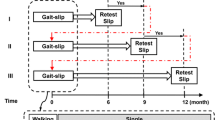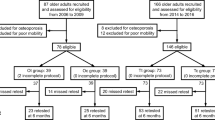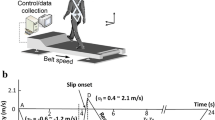Abstract
Identifying effective interventions is vital in preventing slip-induced fall accidents in older adults. The purpose of the current study was to evaluate the efficacy of moveable platform training in improving recovery reactions and reducing fall frequency in older adults. Twenty-four older adults were recruited and randomly assigned to two groups (training and control). Both groups underwent three sessions including baseline slip, training, and transfer of training on a slippery surface. Both groups experienced two slips on a slippery surface, one during the baseline and the other (after 2 weeks) during the transfer of training session. In the training session, the training group underwent twelve simulated slips using a moveable platform while the control group performed normal walking trials. Kinematic, kinetic, and EMG data were collected during all the sessions. Results indicated a reduced incidence of falls in the training group during the transfer of training trial as compared to the control group. The training group was able to transfer proactive and reactive control strategies learned during training to the second slip trial. The proactive adjustments include increased center-of-mass velocity and transitional acceleration after training. Reactive adjustments include reduction in muscle onset and time to peak activations of knee flexors and ankle plantar flexors, reduced ankle and knee coactivation, reduced slip displacement, and reduced time to peak knee flexion, trunk flexion, and hip flexion velocities. In general, the results indicated a beneficial effect of perturbation training in reducing slip severity and recovery kinematics in healthy older adults.







Similar content being viewed by others
References
Baratta, R., M. Solomonow, B. H. Zhou, D. Letson, R. Chuinard, and R. D’Ambrosia. Muscular coactivation. Am. J. Sports Med. 16(2):113–122, 1988.
Bhatt, T., and Y. C. Pai. Generalization of gait adaptation for fall prevention: from moveable platform to slippery floor. J. Neurophysiol. 101(2):948–957, 2009.
Bhatt, T., E. Wang, and Y. C. Pai. Retention of adaptive control over varying intervals: prevention of slip-induced backward balance loss during gait. J. Neurophysiol. 95(5):2913–2922, 2006.
Bieryla, K. A., M. L. Madigan, and M. A. Nussbaum. Practicing recovery from a simulated trip improves recovery kinematics after an actual trip. Gait Posture 26(2):208–213, 2007.
Brady, R., M. Pavol, T. Owings, and M. Grabiner. Foot displacement but not velocity predicts the outcome of a slip induced in young subjects while walking. J. Biomech. 33(7):803–808, 2000.
Brener, J. Sensory and perceptual determinants of voluntary visceral control. In: Bio-Feedback: Theory and Research, edited by G. E. Schwartz, and J. Beatty. New York: Academic Press, 1977, pp. 29–66.
Briggs, J. Sports Therapy: Theoretical and Practical Thoughts and Considerations. Chichester: Corpus Publishing, 2001.
Buchner, D. M., M. E. Cress, B. J. de Lateur, P. C. Esselman, A. J. Margherita, R. Price, et al. The effect of strength and endurance training on gait, balance, fall risk, and health services use in community-living older adults. J. Gerontol. A Biol. Sci. Med. Sci. 52(4):M218–M224, 1997.
Campbell, A. J., M. C. Robertson, M. M. Gardner, R. N. Norton, M. W. Tilyard, and D. M. Buchner. Randomised controlled trial of a general practice programme of home based exercise to prevent falls in elderly women. BMJ 315(7115):1065–1069, 1997.
Carolan, B., and E. Cafarelli. Adaptations in coactivation after isometric resistance training. J. Appl. Physiol. 73(3):911–917, 1992.
Cham, R., and M. S. Redfern. Changes in gait when anticipating slippery floors. Gait Posture 15(2):159–171, 2002.
Chambers, A. J., and R. Cham. Slip-related muscle activation patterns in the stance leg during walking. Gait Posture 25(4):565–572, 2007.
Dick, M. B., S. Hsieh, C. Dick-Muehlke, D. S. Davis, and C. W. Cotman. The variability of practice hypothesis in motor learning: does it apply to Alzheimer’s disease? Brain Cogn. 44:470–489, 2000.
Drowatzky, K. L., and J. N. Drowatzky. Physical training programs for the elderly. Clin. Kinesiol. 53:52–62, 1999.
Dunn, T. G., S. E. Gillig, S. E. Ponser, and N. Weil. The learning process in biofeedback: is it feed-forward or feedback? Biofeedback Self Regul. 11(2):143–155, 1986.
Enoka, R. M. Neuromechanics of Human Movement. Champaign, IL: Human Kinetics, pp. 298–299, 2008.
Gordon, C. R., W. A. Fletcher, J. G. Melvill, and V. R. Edgerton. Adaptive plasticity in the control of locomotor trajectory. Exp. Brain Res. 102:540–545, 1995.
Grabiner, M. D., S. Donovan, M. L. Bareither, J. R. Marone, K. Hamstra-Wright, S. Gatts, et al. Trunk kinematics and fall risk of older adults: translating biomechanical results to the clinic. J. Electromyogr. Kinesiol. 18(2):197–204, 2008.
Grillner, S. The role of muscle stiffness in meeting the changing postural and locomotor requirements for force development by the ankle extensors. Acta Physiol. Scand. 82(1):92–108, 1972.
Guyton, A. C. Textbook of Medical Physiology. Philadelphia: Saunders, pp. 534–536, 562–564, 1981.
Hausdorff, J. M., D. A. Rios, and H. K. Edelberg. Gait variability and fall risk in community-living older adults: a 1-year prospective study. Arch. Phys. Med. Rehabil. 82(8):1050–1056, 2001.
Hodgson, J. A., R. R. Roy, R. DeLeon, B. Dobkin, and R. V. Edgerton. Can the mammalian lumbar spinal cord learn a motor task? Med. Sci. Sports Exerc. 26(12):1491–1497, 1994.
Jensen, L., T. Prokop, and V. Dietz. Adaptational effects during human split-belt walking: influence of afferent input. Exp. Brain Res. 118(1):126–130, 1998.
Kannus, P., H. Sievänen, M. Palvanen, T. Järvinen, and J. Parkkari. Prevention of falls and consequent injuries in elderly people. Lancet 366(9500):1885–1893, 2005.
Kottke, F. J., D. Halpern, J. K. M. Easton, A. T. Ozel, and C. A. Burrill. The training of coordination. Arch. Phys. Med. Rehabil. 59:567–572, 1978.
Lam, T., M. Anderschitz, and V. Dietz. Contribution of feedback and feedforward strategies to locomotor adaptations. J. Neurophysiol. 95(2):766–773, 2006.
Lee, T. D., L. R. Swanson, and A. L. Hall. What is repeated in a repetition? Effects of practice conditions on motor skill acquisition. Phys. Ther. 71(2):150–156, 1991.
Lockhart, T. An integrated approach towards identifying age-related mechanisms of slip initiated falls. J. Electromyogr. Kinesiol. 18(2):205–217, 2008.
Lockhart, T., and S. Kim. Relationship between hamstring activation rate and heel contact velocity: factors influencing age-related slip-induced falls. Gait Posture 24(1):23–34, 2006.
Lockhart, T., and J. Liu. Effects of aging on lower extremity joint torque and muscle activation patterns during slip-induced falls. J. Biomech. 39(Supplement 1):S87, 2006.
Lockhart, T., and J. Smith. Effects of aging on the biomechanics of slips and falls. Hum. Factors 47(4):708–729, 2005.
Lockhart, T., J. Wolstad, and J. Smith. Effects of age-related gait changes on biomechanics of slips and falls. Ergonomics 46(12):1136–1140, 2003.
Mansfield, A., A. Peters, B. Liu, and B. Maki. A perturbation-based balance training program for older adults: study protocol for a randomised controlled trial. BMC Geriatr. 7(1):12, 2007.
Marigold, D. S., A. J. Bethune, and A. E. Patla. Role of the unperturbed limb and arms in the reactive recovery response to an unexpected slip during locomotion. J. Neurophysiol. 89(4):1727–1737, 2003.
Osternig, L. R., B. L. Caster, and C. R. James. Contralateral hamstring (biceps femoris) coactivation patterns and anterior cruciate ligament dysfunction. Med. Sci. Sports Exerc. 27(6):805–808, 1995.
Pai, Y.-C., and J. Patton. Center of mass velocity-position predictions for balance control. J. Biomech. 30(4):347–354, 1997.
Parijat, P., and T. E. Lockhart. Effects of quadriceps fatigue on the biomechanics of gait and slip propensity. Gait Posture 28(4):568–573, 2008.
Pavol, M. J., and Y. C. Pai. Feedforward adaptations are used to compensate for a potential loss of balance. Exp. Brain Res. 145(4):528–538, 2002.
Perkins, P. J. Measurement of Slip Between the Shoe and Ground During Walking, Vol. 649. American Society of Testing and Materials Special Technical Publication, West Conshohocken, PA, pp. 71–87, 1978.
Rudolph, K. S., M. J. Axe, T. S. Buchanan, J. P. Scholz, and L. Snyder-Mackler. Dynamic stability in the anterior cruciate ligament deficient knee. Knee Surg. Sports Traumatol. Arthrosc. 9(2):62–71, 2001.
Schmidt, R. A. A schema theory of discrete motor skill learning. Psychol. Rev. 82(4):225–260, 1975.
Steadman, J., N. Donaldson, and L. Kalra. A randomized controlled trial of an enhanced balance training program to improve mobility and reduce falls in elderly patients. J. Am. Geriatr. Soc. 51(6):847–852, 2003.
Sterling, D. A., J. A. O’Connor, and J. Bonadies. Geriatric falls: injury severity is high and disproportionate to mechanism. J. Trauma 50(1):116–119, 2001.
Strandberg, L., and H. Lanshammar. The dynamics of slipping accidents. J. Occup. Accid. 3(3):153–162, 1981.
Tang, P., M. H. Woollacott, and R. K. Y. Chong. Control of reactive balance adjustments in perturbed human walking: roles of proximal and distal postural muscle activity. Exp. Brain Res. 119(2):141–152, 1998.
Tjernstrom, F., P. A. Fransson, A. Hafstrom, and M. Magnusson. Adaptation of postural control to perturbations—a process that initiates long-term motor memory. Gait Posture 15(1):75–82, 2002.
Wang, T. Y., T. Bhatt, F. Yang, and Y. C. Pai. Generalization of motor adaptation to repeated-slip perturbation across tasks. Neuroscience 180:85–95, 2011.
Weber, K. D., W. A. Fletcher, C. R. Gordon, G. M. Jones, and E. W. Block. Motor learning in the “podokinetic” system and its role in spatial orientation during locomotion. Exp. Brain Res. 120(3):377–385, 1998.
Woo, J., A. Hong, E. Lau, and H. Lynn. A randomised controlled trial of Tai Chi and resistance exercise on bone health, muscle strength and balance in community-living elderly people. Age Ageing 36(3):262–268, 2007.
You, J.-Y., Y.-L. Chou, C.-J. Lin, and F.-C. Su. Effect of slip on movement of body center of mass relative to base of support. Clin. Biomech. 16(2):167–173, 2001.
Acknowledgments
This research was supported by the NSF (grant #CBET-0756058) and NIOSH (grant #CDC/NIOSH-R01-OH009222). Additionally, supported by L30 AG022963-04/NIH HHS/United States.
Author information
Authors and Affiliations
Corresponding author
Additional information
Associate Editor Catherine Disselhorst-Klug oversaw the review of this article.
Rights and permissions
About this article
Cite this article
Parijat, P., Lockhart, T.E. Effects of Moveable Platform Training in Preventing Slip-Induced Falls in Older Adults. Ann Biomed Eng 40, 1111–1121 (2012). https://doi.org/10.1007/s10439-011-0477-0
Received:
Accepted:
Published:
Issue Date:
DOI: https://doi.org/10.1007/s10439-011-0477-0




